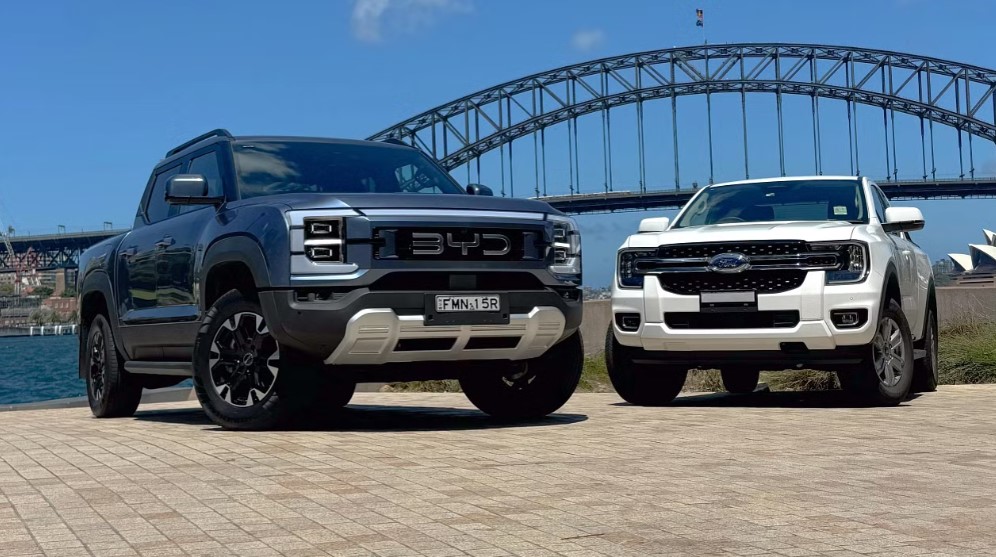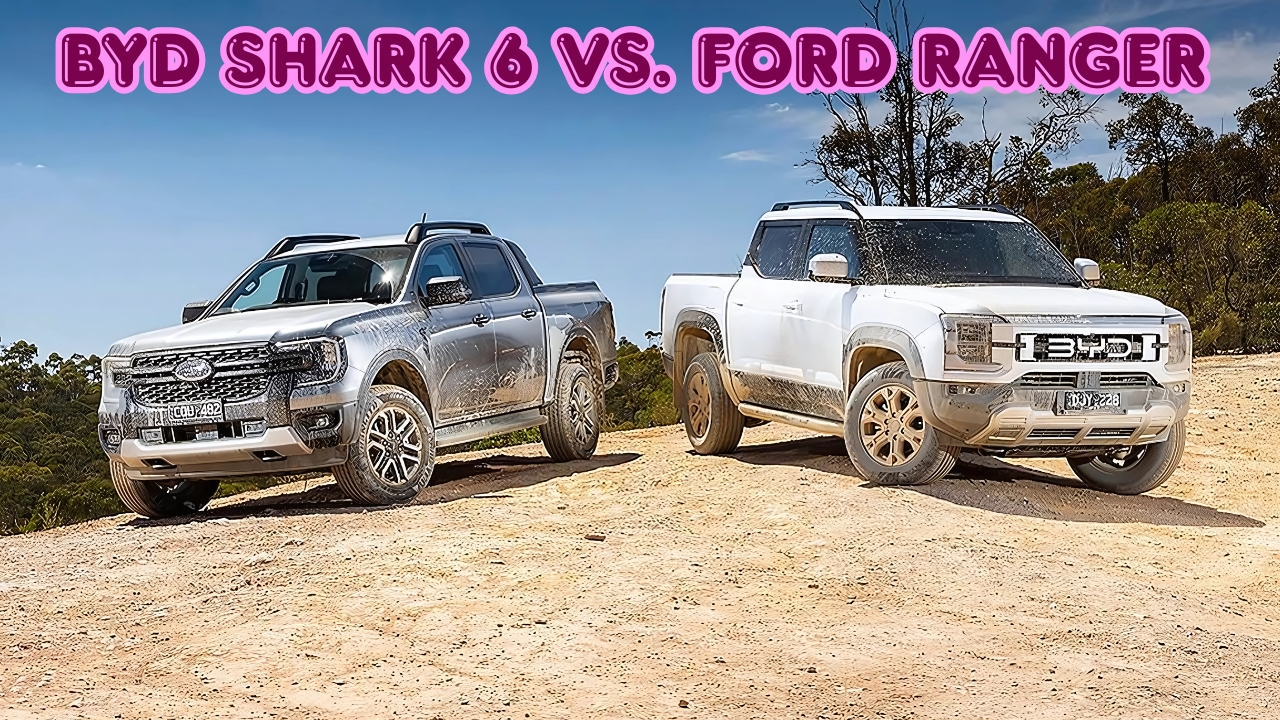BYD Shark 6 vs. Ford Ranger : BYD Australia has completely transformed the local automotive landscape since its debut in 2022. What started as a single electric SUV offering has evolved into a comprehensive six-vehicle lineup that’s challenging traditional automotive giants.
The Chinese electric vehicle manufacturer has delivered over 50,000 vehicles to Australian customers, making it one of the fastest-growing car brands in the country. BYD’s success story represents a fundamental shift in how Australians view electric and hybrid vehicles.
Major Distribution Shakeup: BYD Takes Direct Control
In a significant strategic move, BYD Australia will assume direct control of its vehicle import and distribution operations from July 2025. This transition marks the end of EVDirect’s role as the national distributor, occurring one year ahead of the original schedule.
EVDirect, which successfully launched BYD in Australia, will maintain a 20% stake in the EVDealer Group (EVDG) joint venture with Eagers Automotive. This retail partnership will continue managing BYD’s showrooms and service centers across the nation.
What This Means for Australian Customers
The distribution change promises several improvements for BYD customers. Shorter wait times and enhanced stock availability will result from BYD’s direct supply chain management.
Enhanced after-sales support and expanded retail networks are expected as BYD leverages its global resources. The company aims to provide an industry-leading sales and service experience for Australian drivers.
The BYD Shark 6: Australia’s First PHEV Ute
Revolutionary Pricing Strategy

The BYD Shark 6 Premium arrives with an aggressive price tag of $57,900 plus on-road costs. This pricing strategy positions it as a significant threat to established ute manufacturers like Ford and Toyota.
The Shark 6 is a “whopping $13,440 cheaper” than the Ford Ranger Sport, which retails for $71,340 before on-road costs. This substantial price difference gives BYD a competitive edge in the value-conscious Australian market.
Cutting-Edge PHEV Technology
The Shark 6 features a sophisticated dual-motor all-wheel-drive system combined with a 1.5-litre turbocharged petrol engine. The system produces a “combined power output of 321kW” with impressive torque delivery.
Its 29.58kWh battery pack delivers “100km” of all-electric driving range, making it ideal for daily commuting without using petrol. The total range exceeds 800 kilometers when combining electric and petrol power.
Ford Ranger PHEV: The Established Player’s Response
Premium Positioning and Pricing
Ford’s Ranger PHEV lineup starts from $71,990 for the XLT variant before on-road costs. The range extends to the flagship Stormtrak at $86,990, representing a significant premium over the BYD offering.
There’s “a premium to going petrol-electric in the Ford Ranger, with the plug-in commanding $3150 more in XLT guise” compared to diesel variants. This pricing strategy reflects Ford’s position as an established premium brand.
Traditional 4WD Capabilities
The Ranger PHEV maintains Ford’s renowned off-road capabilities with mechanical four-wheel-drive systems. It features low-range gears, differential locks, and a 3,500kg towing capacity that surpasses the Shark 6’s 2,500kg limit.
Its 11.8kWh battery provides “over 45km” of EV-only range, significantly less than the BYD’s electric-only capability. However, Ford prioritizes traditional ute functionality over extended electric range.
Head-to-Head Comparison: Shark 6 vs Ranger PHEV
Performance and Efficiency
BYD’s advantage lies in its superior electric range and combined power output. The Shark 6 achieves “0-100km/h in 5.7 seconds”, demonstrating impressive acceleration for a dual-cab ute.
The Ford Ranger PHEV focuses on fuel efficiency with a claimed 2.7L/100km consumption figure. Its 70-liter fuel tank provides extended range for long-distance travel and heavy-duty work applications.
Payload and Towing Specifications
Payload capacity reveals a clear winner in Ford’s favor. The Ranger PHEV offers “973kg” payload in XLT configuration, while the Shark 6 provides 790kg capacity.
Towing capabilities show an even larger gap, with Ford’s 3,500kg capacity significantly exceeding BYD’s 2,500kg limit. This difference may influence buyers who require maximum hauling capacity for work or recreation.
Technology and Features
The BYD Shark 6 excels in technology integration with its 15.6-inch rotating touchscreen and comprehensive connectivity features. Heated and ventilated seats, 360-degree cameras, and head-up display come standard.
Ford’s approach emphasizes practical technology like Pro Power Onboard with 6.9kW output for powering tools and equipment. The system includes three power outlets strategically placed throughout the vehicle.
Market Impact and Consumer Response
Initial Sales Success
BYD’s distributor “claims to have already received around 6000 orders for the Shark” within the first month of availability. This overwhelming response demonstrates strong market appetite for affordable PHEV technology.
The compelling price point and advanced features have attracted consumers who previously couldn’t afford hybrid ute technology. BYD’s success challenges traditional assumptions about Australian ute buyers’ preferences.
Industry Transformation
The Shark 6’s arrival has accelerated the electrification timeline for Australia’s ute segment. Traditional manufacturers are now rushing to develop competitive PHEV and electric ute offerings.
GWM’s Cannon Alpha PHEV represents another Chinese challenger entering the market with 37.1kWh battery capacity and competitive pricing. This competition benefits Australian consumers through increased choice and innovation.
Technical Specifications Deep Dive
Battery and Charging Technology
BYD’s Blade Battery technology provides enhanced safety and longevity compared to traditional lithium-ion systems. The 8-year/160,000km warranty demonstrates confidence in the battery’s durability.
Charging capabilities include 7kW AC charging for overnight home charging and 55kW DC fast charging for rapid top-ups during travel. The system supports both Type 2 and CCS combo charging standards.
Drivetrain Innovation
The Shark 6’s dual-motor setup eliminates the need for traditional mechanical 4WD components. Electronic traction control and instant torque delivery provide excellent off-road capability without mechanical complexity.
Regenerative braking helps maximize efficiency and extend electric range during city driving. The system seamlessly transitions between electric, hybrid, and petrol-only operation modes.
The Future of Australian Utes
Electrification Timeline
BYD’s success with the Shark 6 will likely accelerate electrification across the entire ute segment. Toyota, Mitsubishi, and other manufacturers are developing their own PHEV ute offerings.
The government’s fuel efficiency standards and corporate fleet emissions targets will drive further adoption of hybrid and electric utes. Traditional diesel-only options may become increasingly expensive to operate.
Infrastructure Development
Charging infrastructure expansion across regional Australia will support PHEV ute adoption. Government investment in fast-charging networks makes electric driving more practical for work and recreation.
V2L (Vehicle-to-Load) capability in modern PHEVs provides mobile power solutions for remote work sites and camping applications. This technology adds practical value beyond traditional ute capabilities.
Buying Considerations for Australian Consumers
Total Cost of Ownership
BYD’s lower purchase price and reduced fuel costs create compelling economics for many buyers. The FBT exemption for qualifying buyers further reduces the total ownership cost.
Service and maintenance costs may differ significantly between traditional mechanical systems and modern PHEV technology. BYD offers 12-month/20,000km service intervals compared to more frequent diesel servicing requirements.
Practical Applications
Urban and suburban users will benefit most from the Shark 6’s extended electric range and efficiency. Tradies with lighter payload requirements may find the BYD’s features and pricing attractive.
Traditional ute users requiring maximum towing and payload capacity may prefer the Ford Ranger PHEV’s proven mechanical systems. The choice depends on individual usage patterns and priorities.
A New Era for Australian Utes
The BYD Shark 6 represents a fundamental shift in Australia’s ute market, offering advanced PHEV technology at an accessible price point. Its success challenges established players to innovate and adapt to changing consumer preferences.
Ford’s Ranger PHEV maintains advantages in traditional ute capabilities while embracing hybrid technology. The competition between these models will drive innovation and benefit Australian consumers through improved choice and value.
Frequently Asked Questions
Q: How much cheaper is the BYD Shark 6 compared to Ford Ranger PHEV? A: The Shark 6 starts at $57,900, making it approximately $14,000-$29,000 cheaper than Ford Ranger PHEV variants.
Q: What is the electric-only range of each vehicle? A: BYD Shark 6 offers 100km electric range, while Ford Ranger PHEV provides over 45km electric-only driving.
Q: Which ute has better towing capacity? A: Ford Ranger PHEV leads with 3,500kg towing capacity versus BYD Shark 6’s 2,500kg limit.

